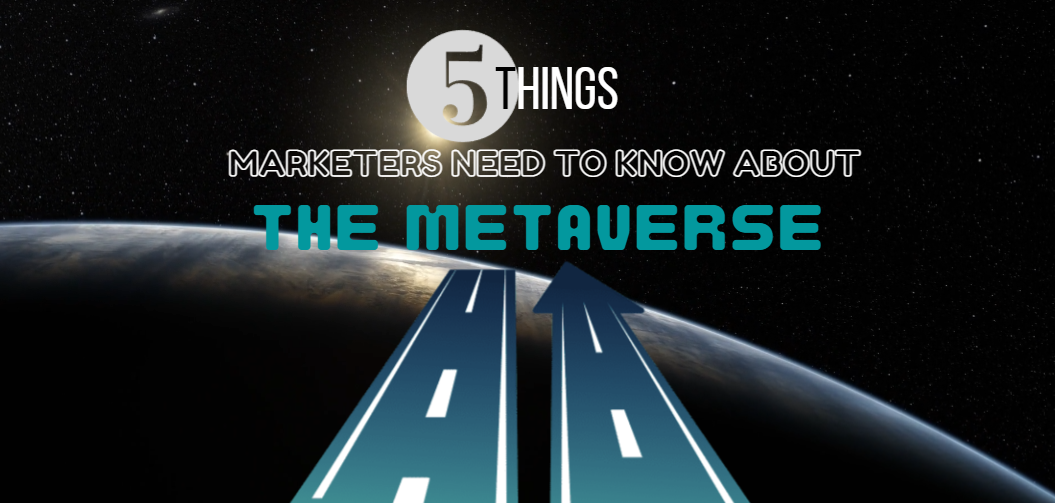5 THINGS MARKETERS NEED TO KNOW ABOUT THE METAVERS …

The METAVERSE was already a top buzzword contender in 2021, but when Facebook announced they are changing their corporate name to Meta to signal an increasing focus on the metaverse, things soared to a whole new level.
Facebook’s rebranding is yet another indication that brands need to move and adapt quickly to capitalize on every opportunity within the metaverse, because technological developments across IT platforms, gadgets, connectivity, and more, are helping to create more realistic human interactions and highly immersive experiences than ever before. Together with advanced behavioral changes and greater dependence on digital infrastructure in our daily lives, there are countless possibilities for brands to dive in.
However, many brands are still uncertain of what they can do or should do at this moment to take the leap of faith and integrate the metaverse into their marketing plans. Therefore, without further ado, here are few numbers of ways for brands to prioritize to become the main gateway to most digital experiences.
#1 From virtual fashion or in-gaming items to virtual real estate, people are paying serious money for virtual possessions. As gaming and social apps today support more creativity and design variation, people are willing to spend more for virtual items that help signifying their character and values, just as they would in the real world.
For instance, the most immediate opportunity is to create apparel items for in-game or social experiences. The biggest opportunities involved partnering with top games branding like Fortnite, League of Legends, etc. These platforms are extremely selective and will work closely with you to enhance gaming experience in a native way (e.g., luxury fashion house Balenciaga teaming up with Fortnite). Similarly, you can create branded skins on platforms that have open marketplaces, like The Sims or Animal Crossing.
Brands can create mesmerizing, virtual-fashion augmented-reality (AR) lenses on Snapchat, which has the best full-body tracking capabilities. Dept launched our first virtual fashion lens back in 2019 for the online fashion store ASOS and its Gen Z brand Collusion. When the lens recognizes items from the gaming-influenced clothing collection, we can animate the clothes in AR.
#2 As society spends more time online, we value digital assets more and express this through the acquisition of virtual ownership. The most popular form of virtual ownership is non-fungible tokens (NFTs), which give us a way to transfer ownership of virtual assets between people and companies or creators.
Some brands have launched limited NFT editions, most notably NBA Top Shot which has driven over $700 million in NFT sales since launch. Major brands like Coca-Cola, McDonald’s,and Adidas have also launched their personal limited collections.
Many brands are still uncertain where to start with NFTs, which is why we recently launched the first open-source, white-label solution to support launching an NFT marketplace, built on top of the Algorand blockchain. The new marketplace makes it convenient and simple for you to build and launch your own NFTs in a matter of days.
#3 You can build fully immersive, 3D virtual venues, worlds, and spaces from scratch. One of the most immediate opportunities for brands in the metaverse currently is creating virtual platforms or stages to host events and experiences. It is a creative strategy adopted similarly to the first branded websites.
For instance, with more restricted rules regarding gatherings these days, Eurovision needed to create a virtual version of its annual song festival. Together, we created a groundbreaking virtual experience for 500,000 visitors that captured the atmosphere of Eurovision and the host city Rotterdam, in the Netherlands, with 3D experiences and contents that refresh every day.
Brands can also partner with existing virtual worlds to host events within them, like Gucci within Roblox and Coca-Cola within Decentraland. Fortnite also continuously releases new areas to the Fortnite map in partnership with brands like Disney (for Star Wars) and Marvel (for Captain America, Deadpool, etc).
#4 The line between digital and physical experiences is rapidly fading, creating new forms of entertainment and extended reality experiences. These new experiences are often interactive, experienced “together,” adding a visual layer to reality or transposing traditional real life behaviors into digital platforms.
These experiences are commonly found in mobile-based AR, but Snapchat’s latest glasses are a big step ahead. These lenses overlay AR directly on top of the view through the lenses rather than augmenting footage retrospectively. Snapchat also released new connected lenses, where you can co-experience AR with someone else using a different phone, which introduces a sense of physicality into the digital experience.
Not just Snapchat, other brands are experimenting in this space with live events. Amazon Prime launched the world’s first real-life gaming experience played out live on Twitch for the premiere of the movie Without Remorse. The event was designed like a real theater show, which users can interact like in a game, was filmed like a commercial and broadcast like a sporting event.
#5 If people cannot engage with you in person, you can create a virtual store or exhibition. As the world locked down in response to curb the pandemic, retailers rapidly invested in digital replicas of their in-store experience. If people cannot come to your physical store, you have to take the 3D experience of your brand to them.
There are many ways to enter the metaverse
As you can see, there is no one way to start experimenting in the metaverse. You might not have the technical resources of a household name brand, but any brand has the ability to start small or from scratch. Metaverse is a new world of many possibilities. Start or do it now, spread your creativity, be “playful”, most importantly don’t get left behind.
